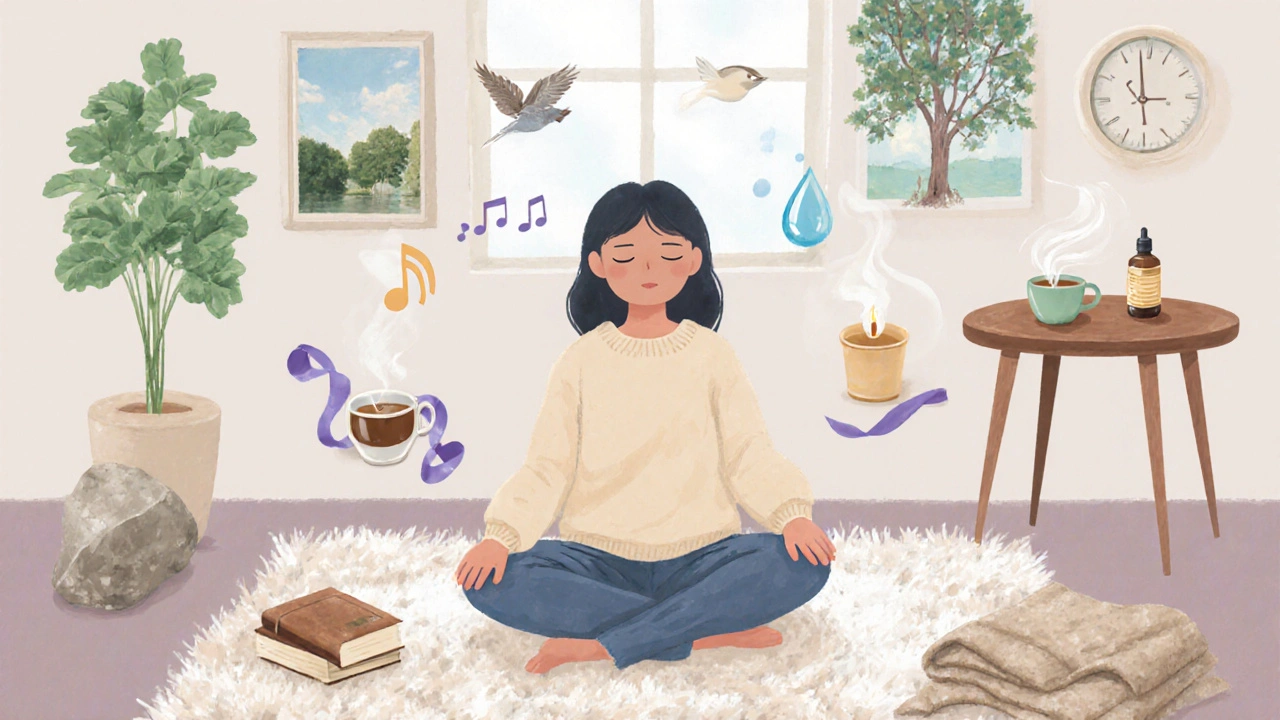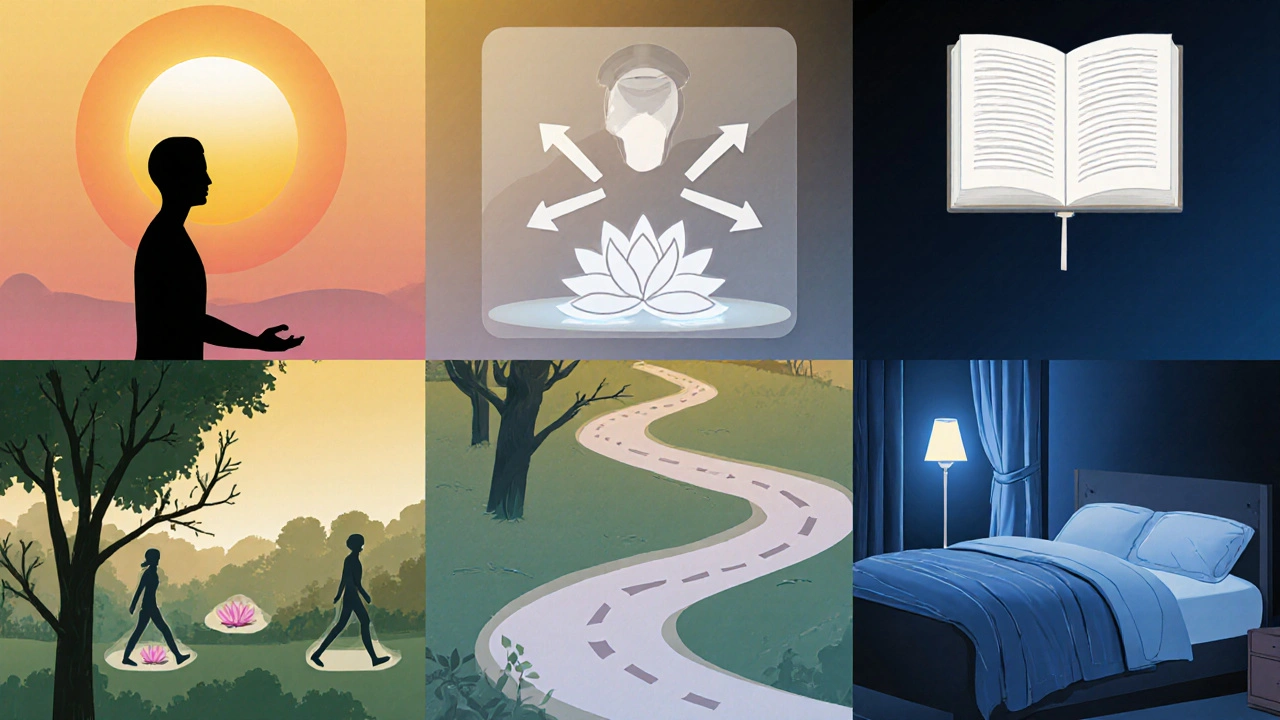PTSD Agitation Coping Strategy Selector
Your Recommended Coping Strategies
Click the button above to get personalized recommendations based on your selections.
When agitation spikes after a traumatic episode, the world can feel like it’s on fire. For anyone living with post‑traumatic stress disorder, those sudden bursts of restlessness, irritability, and panic aren’t just uncomfortable-they can derail daily life. The good news? A blend of practical techniques, lifestyle tweaks, and professional support can calm the storm and reclaim a sense of control.
Understanding Agitation in PTSD
Agitation in post‑traumatic stress disorder (PTSD) is a state of heightened emotional and physiological arousal that often follows intrusive memories, hypervigilance, or perceived threats. It manifests as racing thoughts, clenched muscles, quick speech, and an urge to flee or fight, even when no danger is present.
PTSD itself is a mental‑health condition triggered by experiencing or witnessing extreme stress. It is characterized by flashbacks, avoidance, negative mood shifts, and changes in arousal levels. While many associate PTSD primarily with flashbacks, agitation is a common but less talked‑about symptom that can intensify the overall burden.
Why Agitation Happens
Three key factors fuel agitation:
- Neurochemical imbalance: The brain’s stress‑response system releases cortisol and adrenaline, keeping the nervous system on high alert.
- Trauma‑linked triggers: Smells, sounds, or visual cues that echo the original event can reignite the fight‑or‑flight circuit.
- Compounded stressors: Sleep loss, caffeine, and unresolved emotions create a feedback loop that magnifies agitation.
Understanding these drivers helps you target the right coping tools instead of merely reacting to the symptoms.

Quick Relief Techniques
When agitation hits, you need fast‑acting tactics that calm both mind and body. Below are three evidence‑based moves you can try in the moment.
1. Grounding with the 5‑4‑3‑2‑1 Method
Grounding techniques focus on sensory input to anchor attention in the present are especially useful for disrupting intrusive thoughts. The 5‑4‑3‑2‑1 method guides you to:
- Identify five things you can see.
- Touch four objects and note their texture.
- Listen for three distinct sounds.
- Notice two smells.
- Recognize one taste.
This deliberate shift pulls your brain out of the trauma loop and back into reality.
2. Deep Breathing with Box Technique
Deep breathing activates the parasympathetic nervous system, lowering heart rate and anxiety can be done anywhere.
Box breathing follows a simple four‑second square:
- Inhale for four seconds.
- Hold for four seconds.
- Exhale for four seconds.
- Hold again for four seconds.
Repeating the cycle three to five times often brings a noticeable reduction in tension.
3. Physical Movement - Short Walk or Stretch
Even a five‑minute walk around the block releases endorphins, which counteract the stress hormones fueling agitation. If you can’t step outside, a quick series of shoulder rolls, neck stretches, and calf raises can achieve a similar calming effect.
Building a Long‑Term Coping Toolkit
Quick fixes are essential, but sustained relief comes from integrating habits that reshape your nervous system over weeks and months.
Mindfulness Meditation
Regular mindfulness practice trains the brain to observe thoughts without judgment, weakening the grip of trauma‑related rumination. Start with ten minutes a day using a guided app or a simple breath‑focus exercise.
Structured Exercise Routine
Physical exercise improves mood, regulates sleep, and reduces cortisol levels doesn’t have to be intense. Consistent moderate activity-like brisk walking, cycling, or yoga-three times weekly supports emotional stability.
Sleep Hygiene
Sleep deprivation amplifies agitation. Adopt a wind‑down ritual: dim lights an hour before bed, limit screen exposure, and keep the bedroom cool and quiet. If nightmares interrupt sleep, consider scheduled “worry time” earlier in the evening to process distressing thoughts.
Social Support Networks
Connecting with trusted friends, family, or support groups provides validation and reduces isolation. Share your coping plan with someone who can check in during high‑stress periods.
Professional Therapies
Evidence‑based therapies such as Cognitive Behavioral Therapy (CBT) and Eye Movement Desensitization and Reprocessing (EMDR) directly address trauma memories and associated agitation. Working with a licensed therapist creates a safe space to re‑frame triggers and develop personalized coping scripts.
Medication Management
When agitation persists despite lifestyle changes, a psychiatrist may prescribe medications like selective serotonin reuptake inhibitors (SSRIs) or prazosin to modulate the underlying neurochemistry. Medication is most effective when combined with psychotherapy and self‑care practices.
When to Seek Professional Help
If any of the following occur, reaching out to a mental‑health professional is crucial:
- Agitation levels make it impossible to perform daily tasks.
- Feelings of hopelessness or thoughts of self‑harm emerge.
- Physical symptoms (e.g., rapid heartbeat, chest pain) persist despite calming techniques.
- Substance use increases as a way to manage agitation.
Early intervention prevents escalation and opens pathways to tailored treatment plans.

Comparison of Common Coping Strategies
| Technique | Speed of Relief | Skill Level | Long‑Term Benefits |
|---|---|---|---|
| Grounding (5‑4‑3‑2‑1) | Immediate | Beginner | Improves present‑moment awareness |
| Box Breathing | Immediate | Beginner | Strengthens autonomic regulation |
| Short Walk / Stretch | Fast | Beginner | Boosts endorphins, supports cardiovascular health |
| Mindfulness Meditation | Moderate (minutes of practice) | Intermediate | Reduces rumination, enhances emotional resilience |
| CBT / EMDR Therapy | Variable (sessions) | Professional | Addresses root trauma, lowers overall arousal |
| Medication (SSRIs, etc.) | Variable (days‑weeks) | Professional | Stabilizes neurochemical balance |
Putting It All Together: A Sample Daily Plan
Here’s a realistic 24‑hour routine that weaves the strategies above into a seamless flow:
- Morning (7:00am) - 5‑minute gentle stretch + box breathing.
- Breakfast - Limit caffeine; add a protein source for steady energy.
- Mid‑morning (10:30am) - 10‑minute mindfulness meditation.
- Lunch break - 15‑minute walk outdoors, practice grounding on return.
- Afternoon slump (3:00pm) - Quick grounding exercise if irritability spikes.
- Dinner - Light, balanced meal; avoid heavy, spicy foods that disrupt sleep.
- Evening (9:00pm) - Journaling for “worry time”, then wind‑down routine (dim lights, no screens).
- Bedtime (10:30pm) - 5‑minute body‑scan meditation; keep bedroom cool and dark.
Adjust timings to fit your schedule, but the key is consistency. Over weeks, the body learns new patterns, and agitation becomes less frequent and less intense.
Frequently Asked Questions
Can I treat PTSD agitation without medication?
Yes. Many people find that a combination of grounding, breathing, regular exercise, mindfulness, and therapy significantly reduces agitation. Medication is typically considered when symptoms remain severe despite these interventions.
How long does it take for breathing exercises to work?
Box breathing can lower heart rate within a few minutes. Consistent daily practice strengthens the nervous system, making the response faster over time.
Is grounding safe for everyone?
Grounding is a low‑risk technique suitable for most adults. Individuals with severe dissociation should use it under therapist guidance to avoid feeling overwhelmed.
What role does sleep play in managing agitation?
Poor sleep amplifies the brain’s stress response, making agitation more likely. Prioritizing consistent, restorative sleep can dramatically lower baseline arousal levels.
When should I consider professional therapy?
If agitation interferes with work, relationships, or leads to unsafe behaviors, it’s time to consult a mental‑health professional. Early therapy also helps prevent chronic escalation.








chris macdaddy
October 7, 2025 AT 13:40Take a deep breath and remember you’ve got tools to ride out the storm.
Moumita Bhaumik
October 7, 2025 AT 19:13The so‑called “grounding” tricks are just a way for pharma to keep us hooked on meds while they profit off our anxiety.
Sheila Hood
October 8, 2025 AT 00:47Sure, box breathing works – if you can actually remember to inhale without thinking about your to‑do list.
Melissa Jansson
October 8, 2025 AT 06:20Let’s be real: the “quick relief” chart looks like a corporate PowerPoint designed to sell you a subscription, not a lived‑in solution for trauma‑laden brains.
Max Rogers
October 8, 2025 AT 11:53When you’re feeling the rush, a five‑minute stretch followed by box breathing can drop heart rate; just keep the movements slow and intentional.
Louie Hadley
October 8, 2025 AT 17:27Mixing short walks with mindfulness creates a feedback loop that gradually re‑sets your nervous system.
Ginny Gladish
October 8, 2025 AT 23:00From a physiological standpoint, agitation spikes when the amygdala stays hyper‑active; interventions that engage the prefrontal cortex, like grounding, can dampen that response.
Faye Bormann
October 9, 2025 AT 04:33Imagine you’re stuck in a loop of “what‑if” thoughts; the 5‑4‑3‑2‑1 technique acts like a mental reset button, pulling you out of that spiral and anchoring you back to the present moment. It’s not magic, but repeated practice builds a neural pathway that favors sensory observation over rumination. The beauty of it is that you don’t need any fancy equipment – just your own senses. When you notice a spike, pause, name five things you see, then shift to touch, sound, smell, and taste. Each step drains a bit of the adrenaline surge, giving your body a chance to settle. Over weeks, you’ll find the reflex becomes almost automatic, like a well‑practiced dance move. That’s why clinicians push it as a first‑line tool: low cost, high accessibility, and minimal side‑effects. So next time you feel that rush, try the method – you might be surprised at how quickly it can calm the storm.
Kathy Butterfield
October 9, 2025 AT 10:07Aw, you’re right – it’s wild how quickly a simple grounding exercise can cut through the fog.
Zane Nelson
October 9, 2025 AT 15:40The article’s tone feels like a polished brochure; it would benefit from acknowledging the messy reality of trauma work rather than presenting a checklist.
Sahithi Bhasyam
October 9, 2025 AT 21:13Nice summary! Just a tiny note: “breathing” should be “breath‑control” when you’re talking about the autonomic response; also, the “walk” suggestion could be limited for those with mobility issues.
mike putty
October 10, 2025 AT 02:47Adding a quick stretch before the box breathing makes the transition smoother and helps release muscular tension that often builds up during agitation.
Kayla Reeves
October 10, 2025 AT 08:20Sounds like a checklist for people who think a quick fix replaces real therapy.
Abhinanda Mallick
October 10, 2025 AT 13:53Honestly, these “self‑help” tips are just Western soft‑power trying to make us think we’re independent when the real problem is systemic neglect of mental health resources.
Richard Wieland
October 10, 2025 AT 19:27Grounding techniques, such as the 5‑4‑3‑2‑1 method, work by shifting the focus from internal hyper‑arousal to external sensory input, which engages the dorsolateral prefrontal cortex. This region is responsible for executive function and can inhibit amygdala activity when activated. By naming five things you see, you provide visual stimulation that competes with intrusive memories. Touching four objects adds a tactile dimension, reinforcing proprioceptive feedback. Listening for three distinct sounds recruits auditory processing pathways, further distracting the limbic system. Two smells stimulate the olfactory bulb, which has direct connections to memory centers, allowing you to reinterpret trauma‑linked cues. Finally, recognizing one taste offers a gustatory anchor that can be soothing, especially if it’s something pleasant. The cumulative effect of these steps creates a multimodal sensory cascade that dampens the sympathetic nervous response. Repeated practice strengthens neural pathways associated with present‑moment awareness, making the technique more automatic over time. Studies have shown that after consistent use, participants report lower baseline cortisol levels. Moreover, the simplicity of the method makes it accessible in any environment without equipment. Integrating this with deep‑breathing exercises, like box breathing, amplifies parasympathetic activation. Box breathing, with its equal inhale‑hold‑exhale‑hold pattern, promotes heart‑rate variability, a marker of emotional resilience. When combined, the two methods offer both immediate physiological calming and longer‑term cognitive restructuring. It is important, however, to tailor the approach to individual preferences; some may find the sensory focus overwhelming, especially if they have heightened sensory sensitivities. In such cases, a modified grounding that emphasizes fewer senses can be employed. Overall, these evidence‑based strategies complement formal therapy, providing a toolkit that empowers individuals to manage agitation in the moment.
rachel mamuad
October 11, 2025 AT 01:00Totally agree – consistent sleep hygiene is the unsung hero in calming the nervous system.
Amanda Anderson
October 11, 2025 AT 06:33When the world feels like it’s on fire, even a five‑minute walk can feel like a tiny lighthouse in a storm.